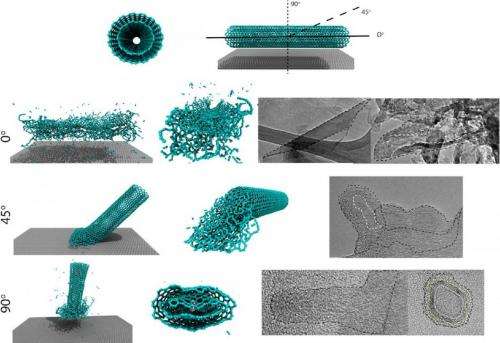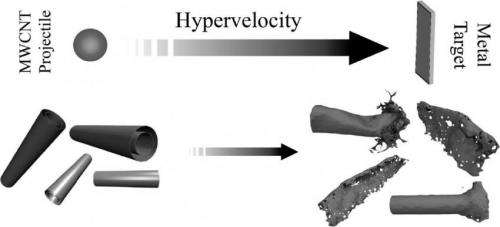June 23, 2014 feature
Scientists shoot carbon nanotubes out of high-speed gun (w/ video)

(Phys.org) —What happens when you shoot multiwalled carbon nanotubes (MWCNTs) out of a gun onto an aluminum target at a velocity of more than 15,000 mph? Scientists finally have the answer. If a nanotube reaches the target at a 90° angle (head-on), it will break and deform quite drastically. However, if it is parallel to the target upon impact, the nanotube will unzip, resulting in a 2D graphene nanoribbon. This observation is unexpected, since previous simulations have shown that nanotubes break into pieces when subjected to large mechanical forces.
Researchers Sehmus Ozden, et al., at Rice University in Houston, Texas, US; the State University of Campinas in Campinas, Brazil; and the Indian Institute of Science in Bangalore, India, have published a paper on the results of their high-impact nanotube collision experiments in a recent issue of Nano Letters.
In their study, the researchers packed MWCNTs as pellets into the vacuum chamber of a light gas gun, a device that is commonly used for hypervelocity impact experiments. The pellets were composed of mostly nonoriented MWCNT bundles, with each pellet having a spherical shape.
Because it was not possible to directly observe the impact due to the nanotubes' small size and high speed, the researchers analyzed the differences in the nanotubes using a transmission electron microscope before and after the impact to extract useful information about what occurs during impact. They also performed molecular dynamics simulations to better understand the effect of the impact.
Although each bundle of nanotubes (the pellet) was shot perpendicular to the target, the individual randomly aligned nanotubes impacted the target at different angles. The researchers found that the impact angle has a large effect on the results of the collision. At a 90° impact angle, the nanotubes deformed along the radial direction, essentially being smashed like the front of a car in a head-on collision. At a 45° impact angle, the nanotubes became partly deformed and partly unzipped.
At a 0° angle, the nanotubes were completely unzipped when shot at the aluminum target. The researchers explain that the unzipping occurs on the scale of femtoseconds. In that short time, many atoms along the side of the nanotube become stressed due to the impact, resulting in the breaking of the carbon bonds in a straight line along the side of the nanotube.

At the 90° and 45° impact angles, on the other hand, fewer atoms were involved in the impact, so the stress was more concentrated on fewer atoms. Many of these atoms ended up being ejected from the nanotube, rather than having their bonds neatly broken as in the 0° impact angle scenario.
Unzipping carbon nanotubes to create 2D graphene nanoribbons is very useful in nanoscience, but until now it has typically been achieved with chemical contaminants that leave back contaminants. By demonstrating for the first time that nanotubes can be quickly unzipped through mechanical means, the new study offers a "clean-cut"—a clean, chemical-free way to produce high-quality graphene nanoribbons. As the researchers explained, graphene nanoribbons have certain advantages over both nanotubes and graphene that make them attractive for applications.
"Graphene nanoribbons are good candidates for active materials in electronics, being the channel of field-effect transistors," coauthor Dr. Robert Vajtai at Rice University told Phys.org. "They are superior to carbon nanotubes, as their bandgap is more predictable. Also, they are superior to graphene itself as graphene has no bandgap, but making a nanometer-scale narrow stripe of it opens the bandgap because of quantum confinement, so it is a semiconductor."
More information: Sehmus Ozden, et al. "Unzipping Carbon Nanotubes at High Impact." Nano Letters. DOI: 10.1021/nl501753n
Journal information: Nano Letters
© 2014 Phys.org


















